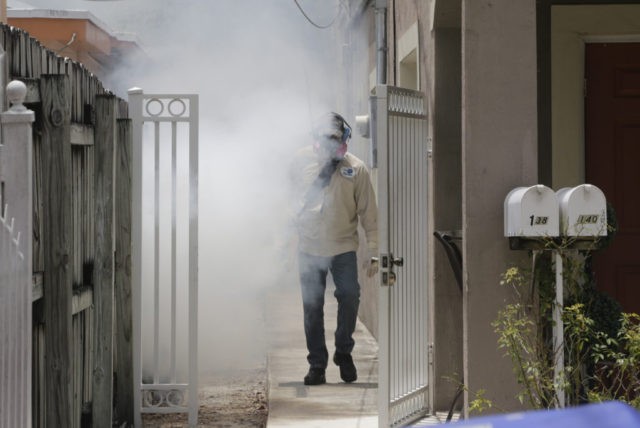With the Centers for Disease Control (CDC) issuing their first warning for Americans to avoid travel to an American neighborhood, the U.S. is on the verge of a Zika pandemic that may soon require extreme measures, including aerial pesticide spraying.
For the first time their 70 year history, the CDC warned Americans on August 1 not to travel to an American neighborhood for fear of catching an infectious disease. The CDC advised pregnant women and their partners not to travel to a Zika infested community near Miami that has 14 cases in a neighborhood with 200 homes and businesses.
Vector borne diseases such as dengue fever, malaria, yellow fever, and Zika infect over 1 billion people and kill over 1 million people per year. Zika is easily spread by 1) mosquito blood bite; 2) mother to child; 3) sex; 4) saliva; 5) urine; 6) blood transfusion; and 7) research laboratory exposure, according to the CDC.
Zika is symptomatic for only 18 percent of cases. If symptoms appear, they are usually associated with a mild flu fever, joint pain, muscle pain, headache and red eyes. Consequently, the Zika infection rate is drastically under reported.
There officially are 433 pregnant women in the U.S. and another 422 in US Territories that have been diagnosed with “Lab Evidence of Zika Virus Infection.” Up to 1 in 7 of these infected pregnant women will give birth to a microcephaly deformed baby.
Zika was first discovered in Uganda monkeys in 1947 and the first human case documented there in 1952. About 100 countries have reported human Zika cases in the last 64 years. There currently are 43 countries and territories officially reporting vector-borne transmission of Zika virus, but it is believed that dozens of other nations have not disclosed such cases, due to worries about the adverse impact on tourism and trade.
Zika has also caused Guillain-Barré syndrome deaths in several countries, including the U.S. GB symptoms are catastrophic pain from protracted internal bleeding.
There is no known cure or vaccine for Zika. Despite decades of research, there is not expected to be any cure or vaccine in the immediate future. Consequently, the virus is predicted to become widespread and result in cases in every U.S. state.
The key national defense against vector borne disease outbreaks jumping from a localized epidemic to a pandemic has been the use of pesticide spraying to control and eliminate mosquito populations.
From 1887 until the enactment of the 1947 Clean Water Act, which established the National Pollutant Discharge Elimination System permit process to regulate and approve pesticides like those that control mosquito populations to be regulated exclusively under the Federal Insecticide, Fungicide and Rodenticide Act (FIFRA), the widespread use of pesticides prevented any of the regularly occurring vector borne outbreaks from becoming a pandemic.
Cities, municipalities and other mosquito-control entities over the next 62 years, frequently used pesticides to control and successfully eliminate mosquito populations to prevent local vector borne outbreaks from going pandemic.
But the Sixth Circuit Court in a 2009 decision, ruled the Environmental Protection Agency had the right to issue another layer of regulations called National Pollutant Discharge Elimination System (NPDES) to permit government pesticide-spraying during vector borne outbreaks.
In a brutal pandemic risk warning, the U.S. suffered an outbreak of vector borne West Nile disease in 2012. Regulatory hurdles restricted many states and communities from early intervention pesticide spraying. By the time the courts issued a Public Health Emergency Order, there were 5,674 human cases of West Nile virus disease, 286 deaths, and every mainland U.S. state suffered an outbreak.
Congressman Bob Gibbs (R-Ohio) introduced bipartisan legislation in April, titled ‘The Zika Vector Control Act,’ that would suspend the NPDES requirements for two years to give state and local governments the flexibility to prevent the spread of mosquitoes and the Zika virus they may carry. The bill requires pesticides used to kill mosquitoes to still be subject to the appropriate regulation and oversight required of FIFRA.
But after the proposed legislation caused an election year environmentalist backlash that included threats to retaliate against the bill’s 23 Democrat sponsors, President Obama stated that he will veto any bill that suspends NPDES.
The World Health Organization in January predicted there would only be 3-4 million Zika cases in the Americas this year. But that was before it was understood that only 18 percent of those infected will show symptoms.
The United States has only suffered four pandemics in its 241 year history: 1) 1830-1851 Cholera Pandemic; 2) 1918 Spanish Flu Pandemic; 3) 1952 Polio Pandemic; and 4) 1957 Asian Flu Pandemic.
EPA regulations have prevented the use of pesticide spaying to control the Zika epidemic. But with the disease now growing at an exponential rate, it is only a matter of time before the American public panics and demands extraordinary measures, such as a national campaign of aerial spraying to stop a Zika pandemic.

COMMENTS
Please let us know if you're having issues with commenting.